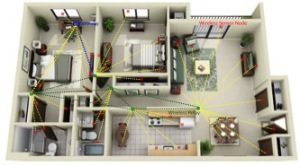A cheap and efficient route to smart homes and offices
Case Western Reserve University engineers are making sensors that can be integrated into existing materials, transforming today’s homes and commercial buildings into energy-saving, tech-savvy “smart buildings.”
Their work is funded by a $750,000 “incubator” award from the U.S. Department of Energy.
A smart building is one equipped with lighting, heating, and electronic devices that can be controlled remotely by phone or computer.
 Philip Feng, assistant professor of electrical engineering and computer science, leads a team that will build wireless sensors and sensor networks that relay the air temperature or the presence of a human in a room to a control hub that turns on or shuts off lights, heating and air conditioning.
Philip Feng, assistant professor of electrical engineering and computer science, leads a team that will build wireless sensors and sensor networks that relay the air temperature or the presence of a human in a room to a control hub that turns on or shuts off lights, heating and air conditioning.
The sensors use no batteries or electrical source. They are powered by vibrations from a swinging door, ventilation fan, television speaker or other movements.
“There’s a lot of need for technology that enables buildings to save energy and increase efficiency,” Feng said, “especially something that can monitor and control power consumption when you’re not there. Our technology removes the battery commonly used in today’s sensors.”
With funding for two years, Feng and Kenneth Loparo, chair of the electrical engineering and computer science department, and Intwine Connect LLC, a suburban Cleveland company with offices on campus, are developing wireless sensor nodes and networks that convert vibrations into electrical energy to monitor temperature distribution and energy consumption, and communicate the information to a control hub.
“If you left a building and forgot to turn off the lights and turn down the heat, you can look at a readout on a smartphone and see the energy being used,” Feng said. A user can adjust energy use by phone, or the central hub can be programmed to do it automatically.

The technology in this project brings advancements in several engineering aspects, including innovative piezoelectric resonant devices to scavenge small vibrations and transient motions that are generally neglected, and ultralow-power application-specific integrated circuits for sensing and wireless communication.
The researchers are designing their sensors to match the vibrational spectra from varying sources—from swinging doors and vent outlets, to refrigerators and air conditioning units and a host of appliances and household features that rock, sway, chatter or oscillate constantly or regularly. By matching, the sensors will get the maximum energy out of each source.
Feng’s lab has been developing model temperature sensors powered by subtle and transient vibrations.
The nickel-size sensors would be easily mounted on the surface of the energy source with peel-and-stick tape to make an existing building smarter. They can also be integrated into the construction of new buildings or used in renovations.
The extended systems would be able to collect information to adjust lighting, heating, cooling or ventilation, based on temperature, humidity or other factors. These wireless sensors would immediately help enable the emerging Internet of Things —allowing objects to collect and send data without human involvement—in next-generation smart buildings.
Feng’s lab will focus on developing arrays of wireless temperature sensors that will be smaller, more efficient and less expensive than those on the market today, he said. The lab will work with Intwine in the sensor network design to fit with the company’s Intwine Connect Gateway communications hub. Loparo will assist with data analytics and communications between the sensor nodes and the hub.
A team of students helping develop and working to commercialize the technology will compete in the regional Clean Energy Challenge in Chicago April 13 and 14. The team, called CrystalE, placed second in the campus-wide Clean Energy Challenge in January.
